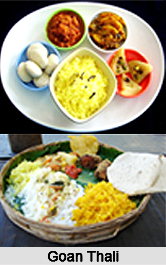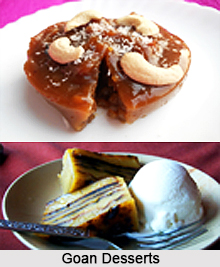 Goa Cuisine is a combination of different influences i.e. Portuguese, Hindu and Christian through the centuries, and though the recipes and techniques have changes and evolved over the years, the basic ingredients remain the same. The staple components of typical Goan food are the local products like rice, fish and coconut and almost every Goan meal will have a dish comprising them. The people of Goa are gourmet seafood eaters and make a variety of delicious soups, salads, pickles, curries and fries.
Goa Cuisine is a combination of different influences i.e. Portuguese, Hindu and Christian through the centuries, and though the recipes and techniques have changes and evolved over the years, the basic ingredients remain the same. The staple components of typical Goan food are the local products like rice, fish and coconut and almost every Goan meal will have a dish comprising them. The people of Goa are gourmet seafood eaters and make a variety of delicious soups, salads, pickles, curries and fries.Goan food today is a fusion of many cuisines. Goan food drew on different influences - Arab, Konkan, Malabar, Malaysian, Portuguese, Brazilian, French, African and even Chinese. There are many dishes common to Goa, Daman, Kerala, Mangalore, Malaysia, Macau, Portugal, Brazil and Sri Lanka. The food of Goa is rich in spices and other ingredients. Cashews play an important role in Goan food and are present in almost all dishes.
Portuguese Influence on Goa Cuisine
The Portuguese brought various goods for their own consumption, trade or as a part of their culture to Goa. Many new food products and customs percolated into Goan society. From the routes discovered and used by the Portuguese came a host of plants producing juicy fruits and vegetables such as potato, tomato, pumpkin, aubergine, cashew nut, chilli, papaya, passion fruit, pineapple and guava. Among these was the use of potato by people of all communities in making savouries such as "Samosas", "Batata Vadas" and "Potato Bhaji" as well as in meat and fish recipes. Rulers, merchants, missionaries, Portuguese women in India played different roles in introducing various types of food, knowledge of food habits and for circulating recipes.
The Portuguese introduced "Sura" instead of the yeast in the process of fermentation in Goa, particularly in the making of wheat bread. Sura was also used to make vinegar introduced in the Goan Christian cuisine by the Portuguese for adding flavour, provide a sour taste and as a preservative in meat, fish, vegetable and pickle recipes.
 Religious Influence on Goa Cuisine
Religious Influence on Goa CuisineReligion and customs also forced Goans to rename some of their recipes or add different ingredients. Goans, particularly the Hindus, did not easily accept all the products brought to India. For instance, the Hindus, due to religious beliefs and at times superstition, resisted the use of certain types of vegetables and other food products in their cuisine. They avoided the great Mediterranean trilogy of bread, meat and wine for a long time. "Pav" was not consumed both because it contained sura and probably because a majority of bakers were Christians and it was a European product. Today, however, people of all communities consume bread, though some Hindus abstain on religious occasions.
In the early period, the Hindus of Goa did not eat tomato. Even today most Goan Hindu families do not cook tomato, aubergine, radish and papaya on festive religious occasions when they prepare food for the Gods since these vegetables are from across the seas and considered polluting. Tomato, a fleshy red fruit is associated with blood, considered polluting. Circumstances forced the Hindu in Goa to eat tomatoes in the early decades of the 20th century during an epidemic of typhoid; where patients were prescribed cod liver oil with tomato juice. Subsequently, Hindus started using tomato in their food.
For more, visit the link below: